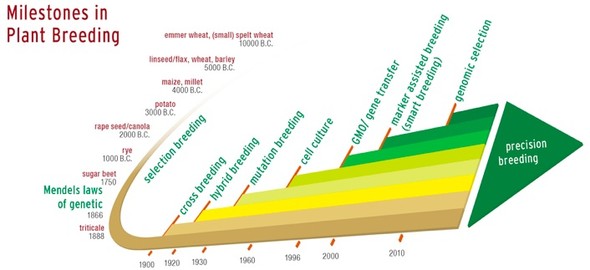 Over the last several thousand years, humans have taken a more active role in the evolution of plants by specifically saving and selecting seed from plants that looked, smelled or tasted particularly interesting. The result was the domestication of plants, making it easier to grow and harvest them and become better, more reliable and nutritious sources of food. This same process continues today, though in a more formalized way, using the science and art of plant breeding.
Over the last several thousand years, humans have taken a more active role in the evolution of plants by specifically saving and selecting seed from plants that looked, smelled or tasted particularly interesting. The result was the domestication of plants, making it easier to grow and harvest them and become better, more reliable and nutritious sources of food. This same process continues today, though in a more formalized way, using the science and art of plant breeding.
No matter the method used, the goal of today’s plant breeders remains the same: producing better seed for a better quality of life. Sometimes the improvement is an addition of a trait, such as resistance to an emerging plant disease. Other times the breeder may change the levels of desirable or undesirable plant compounds. To create a new plant variety, plant breeders generally have relied on two sources of genetic variation as source material for new traits: the inherent diversity in a plant’s gene pool and new, naturally occurring variants of existing genes. Breeders have historically integrated the latest discoveries in plant biology and genetics into their methodologies to fully exploit existing, and induce new, genetic variation.

The first objective for any plant breeding program is to increase genetic variation though genetic crosses or other methods. The process takes multiple generations and results in plant lines that look, smell, taste and yield in a reliable, predictable way. Although every breeding program is slightly unique, they all follow a fairly standard set of procedures.
Some of the latest breeding methods provide new ways to make similar genetic changes. Now breeders can make very specific changes in existing plant genes as they would occur in nature. They can also transfer defined pieces of genetic material within a plant’s gene pool, rather than combining the whole genomes of two plants that transfers both wanted and unwanted genes. By applying these newer methods, plant breeders are more efficient and precise at making the same desired changes that once were made over a much longer period of time through earlier breeding methods.
It’s important to note that the plant varieties developed using these new tools could, in most cases, be developed through classical breeding. Newer technologies are simply speeding up the naturally occurring process, which could otherwise take up to 10 years or more. Thanks to new breeding methods, we are now able to more efficiently meet the need for a wide variety of nutritious and high quality products, while supporting sustainable agriculture practices that preserve our environment’s natural resources and biodiversity.
Take for instance, the tomato. While you would never want to eat a wild tomato, wild varieties have traits for naturally-occurring disease resistance. Through today’s breeding methods, plant breeders are able reduce chemical applications on commercial tomatoes by identifying the naturally-occurring gene in its wild relative and making the same gene in the commercial tomato. This is a win-win for consumers and the environment.
Plant breeders have a phenomenal track record of safety. Varieties improved with the latest breeding methods are subjected to the same critical performance evaluations and processes that breeders have used for many decades to create new plant varieties that are safe to grow and eat.
Through advancements in agriculture and the development of new crop varieties, humans have historically strived to meet the needs of a growing population and develop a safe, reliable and sustainable food supply. How will we continue to meet this challenge, while dealing with a changing climate, threats of new pests and diseases, and ever-changing public demand?
Plant breeders will need access to every tool available to do so in a safe, affordable and responsible manner. The future is here and now; it starts with the seed.
Bernice Slutsky, Ph.D., is senior vice president, domestic and international policy, at the American Seed Trade Association in Alexandria, Va.